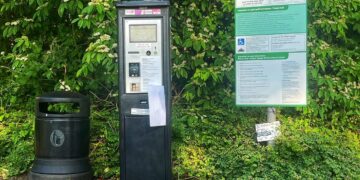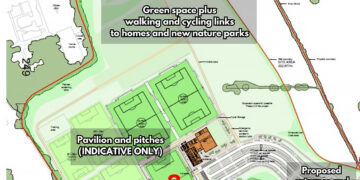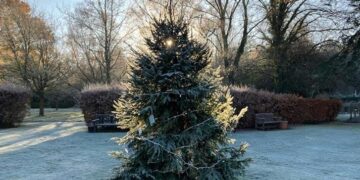Tributes are being paid to a much-loved oak, classified as “a notable ancient tree”, which fell in the recent torrential rain.
By great fortune the tree fell straight between two homes, injuring no-one and leaving the houses undamaged.
The living veteran tree may be lost but there is still some good news for nature.
Wokingham District Veteran Tree Association recognised the importance of the tree, thought to be at least 200 years old, when they put it in their records in 2009. They measured 4.3 metres round its trunk, 1.5 metres above the ground.
The association’s lead tree warden Stephen Loyd of Twyford paid respects to the fallen oak in a grassed area of Broad Hinton, Twyford, visiting to photograph it for the association.
“It had all the characteristics of a good veteran tree, with holes in it and broken bits. It is sad to see it go in one fell swoop like that,” he said. It would take years to replace a tree of that calibre. He guessed it was at least 200 years old.
The tree was in waterlogged ground at the bottom of a hill. “That may have contributed to it falling on that very very wet day [March 31],” he said.
Francesca Hobson, Wokingham Borough Council’s assistant director for environment and safety, had similar thoughts, saying: “It’s hard to say why the tree fell down but, on inspection, we noticed the surrounding area was very heavily waterlogged due to the recent heavy rain so this is likely to have been a contributing factor.
“We know that trees are important for a wide range of reasons, from protecting biodiversity and offsetting carbon emissions to improving people’s health, so we’ll be arranging replacement planting during the 2023/24 season.”
She added: “We’ll do all we can to keep any sizeable oak [pieces] on site where it can be made safe, in order to keep as many environmental and wildlife benefits as we can.”
A council spokesperson said: “The tree is likely to have been providing a habitat for beetle species that feed on decomposing wood (such as stag beetles) for some time already, and could carry on doing so for many years to come.
“So it’s beneficial to keep as much as possible and let it decompose naturally. Given the size of the trunk, it could continue to provide biodiversity benefit for several decades yet.”
Mr Lloyd explained the benefits of oaks, saying: “The New Sylva, a book by Gabriel Hemery, states that oaks ‘are well known to support the richest fauna of any tree species in Britain, with an estimated five hundred invertebrate species [including insects, beetles, bugs and centipedes] being entirely dependent on them’.
“The book also states veteran oaks are important for ‘Their natural ability to hold onto dead limbs and to survive with hollow stems provid[ing] habitat niches for thousands of specialist invertebrates, and for bats, birds, fungi, lichens, mosses and even other tree species that can take root within their rotting hulks’.”
He said trees of the fallen oak’s age stored far more carbon in their trunk, branches and roots than young trees, adding: “I would not use the term ‘off set carbon emissions’ for 200-year-old trees, as that implies compensating our daily emissions. These trees were here before we started our emissions. They should be regarded as carbon stores.”
Mr Loyd said that before the Broad Hinton estate was built it was open fields dotted with veteran oaks. At the time of planning consent the council had said the trees had to remain. There are still oak trees, other than the fallen one, there.
Visit the Wokingham District Veteran Tree Association website at https://www.wdvta.org.uk for details of trees they have recorded throughout the borough.
Branches of the fallen oak which were overhanging homes have been removed.














































